Bowing in Japan: The Quiet Language of Respect
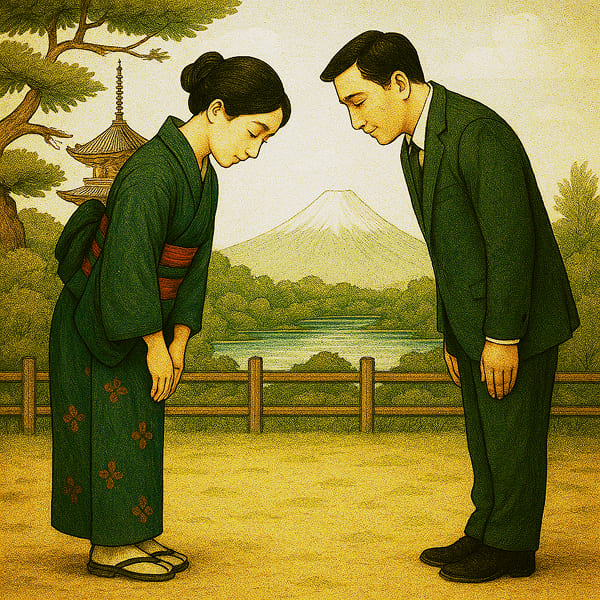
Contents
Did you know that a simple bow can speak more eloquently than words?
In Japan, a bow is more than a polite gesture — it’s a quiet language.
With one motion, people express gratitude, respect, apology, and sincerity.
From tea rooms to offices, this simple act reflects a culture that values harmony and human connection.
Why do people bow in Japan?
What feelings or messages are conveyed through this graceful act?
Let’s take a gentle step into the world of Japanese bowing.
Together, we’ll explore its origins, meanings, etiquette, and how this timeless expression continues to evolve in modern Japan and beyond.
Ojigi: The Heart of Japanese Greetings
So, what exactly is an ojigi (お辞儀) — the Japanese bow?
Before exploring its history and deeper meanings, let’s begin with the basics.
A Gesture That Speaks Without Words
In Japan, bowing is one of the most important forms of etiquette — a simple act of bending the waist and lowering the head.
But did you know it’s not just a set of rules or a routine gesture?
Behind this modest motion lies a quiet form of graceful expression.
Without saying a single word, a Japanese bow can convey feelings such as:
- Respect and appreciation
- Sincere apology
- Humility
- Warm welcome
And remarkably, the person receiving the bow understands these emotions without any need for words.
Unlike a handshake or a hug, bowing expresses intention through posture, timing, and sincerity.
It’s not about physical touch — it’s about a gentle connection built on trust and mutual understanding.
Wherever you go in Japan—from daily greetings to formal occasions—each bow reflects awareness and care for others.
Etiquette in Japan is not only seen, but also quietly understood.

The Meaning Behind Lowering Your Head
So why do Japanese people bend at the waist and lower their heads?
Behind this graceful motion lies a meaning that has been nurtured for centuries.
To bow is to place oneself below the other person, both physically and symbolically.
It’s a gesture that expresses respect through modesty — silently saying:
I honor you, and I am open to you.
During a bow, words are no longer necessary; the gesture itself becomes the message.
From a light nod shared between neighbors to a deep bow expressing apology or gratitude, each variation carries its own tone and emotion.
This calm, wordless movement reflects one of Japan’s most beautiful values — a deep respect for others, and the belief that true connection often begins in silence.
In every bow, there’s a quiet reminder that respect doesn’t need to be loud — it simply needs to be sincere.
Historical Roots – From Samurai to Modern Japan
Now that we’ve learned the basics of bowing, let’s take a step back in time and explore how ojigi became deeply rooted in Japan’s traditions and culture.
Origins in Ancient Japan
The story of bowing in Japan stretches back more than a thousand years.
It is believed to have begun between the Asuka period (538–710) and the Nara period (710–794), when Chinese court etiquette arrived alongside the spread of Buddhism.
In those early days, bowing was not simply a greeting — it was a visible sign of social order.
Before that, people often showed respect by kneeling and lowering their heads to the ground, a gesture similar to today’s dogeza (土下座) — a deeply humble act of apology or submission, performed by kneeling on the floor and touching one’s forehead to the ground to show extreme humility.
Over time, as imperial etiquette developed, bowing shifted from kneeling to standing forms (ryūrei).
Some traditions associate this change with the late 7th-century court, but historians generally describe it as a gradual process, not a single decree.
This change not only reshaped etiquette within the imperial court but also influenced how the elite interacted in daily life — laying the foundation for what would become Japan’s enduring bowing culture.
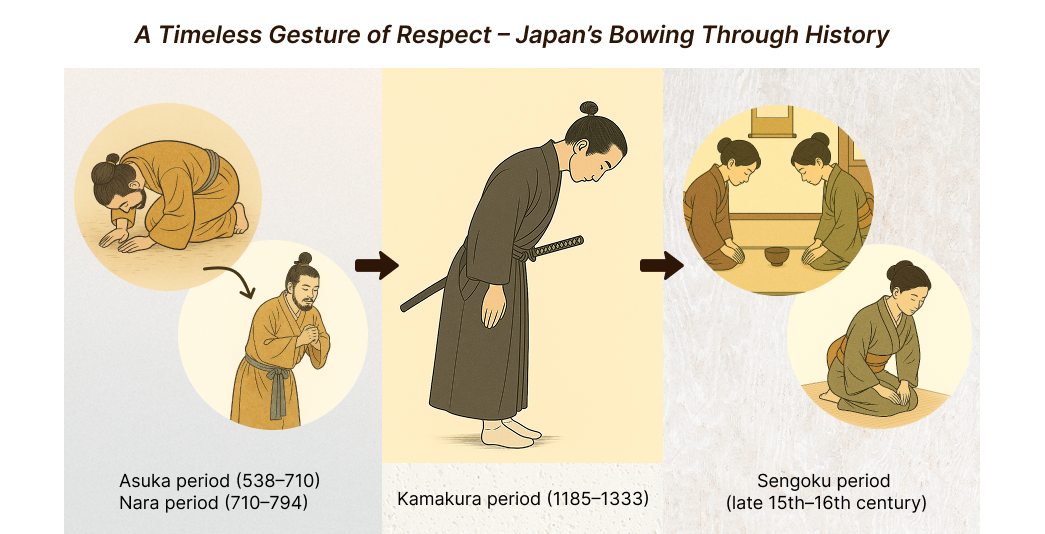
From the Warrior Class to Schools of Etiquette
Centuries later, during the Kamakura period (1185–1333), the rise of the samurai transformed bowing into a disciplined art form.
For the warrior class, every bow was measured and deliberate — a reflection of discipline, loyalty, and respect for hierarchy.
Even the details of kimono, topknots, and swords influenced how a samurai would bow, creating a style both graceful and strong.
These traditions were formalized in etiquette schools such as Ogasawara-ryū, which still preserves many aspects of samurai manners today.
In modern martial arts, this spirit of samurai etiquette has continued to evolve while remaining at the heart of practice.
For example, in karate, practitioners begin and end with a bow accompanied by a loud “Osu!” — a greeting that expresses both respect and fighting spirit, reminding us that even in strength, true humility endures.
Note: The exact words or bowing styles can vary by martial art and school, as each tradition has its own way of expressing respect and discipline.
Bowing in the World of Tea
By the late Sengoku period (late 15th–16th century), Sen no Rikyū had perfected the art of the tea ceremony.
In contrast to the upright postures of samurai and the imperial court, the tea room introduced a gentler, seated bow known as zarei (座礼).
This style emphasized grace, restraint, and mindfulness in every movement.
Unlike the formal, rigid bows of warriors, the seated bow flowed naturally — not rushed or mechanical, but in harmony with the quiet rhythm of the ceremony itself.
Each motion was deliberate, reflecting inner calm and respect for the moment.
The bows of the tea ceremony are traditionally divided into three styles, each defined by its angle and duration:
| Style | Meaning | Description |
|---|---|---|
| Shin (真) | True / Formal | Formal and deeply sincere bow. |
| Gyō (行) | Semi-formal | Gentle yet polite, used between guests. |
| Sō (草) | Casual | Light and natural, like a friendly nod. |
These subtle differences may seem small, but they capture the very essence of tea culture — that true beauty lies in intention and simplicity.
Even today, the seated bow continues to be practiced in tea ceremony, martial arts, and traditional ceremonies such as weddings and funerals throughout Japan.
From imperial edicts to samurai discipline, and the elegance of the tea room, bowing in Japan has continually evolved through the centuries.
Yet its heart remains unchanged: a gesture of respect, humility, and connection — a quiet bridge linking past and present.
Types of Bows – From Casual to Formal
Just as spoken words can carry different tones, bows in Japan also vary in depth, speed, and duration, each expressing a different emotion or level of respect.
From everyday encounters to formal occasions, every bow has its own purpose and feeling.
Let’s take a closer look at the three main types of standing bows most commonly seen in Japanese daily life.
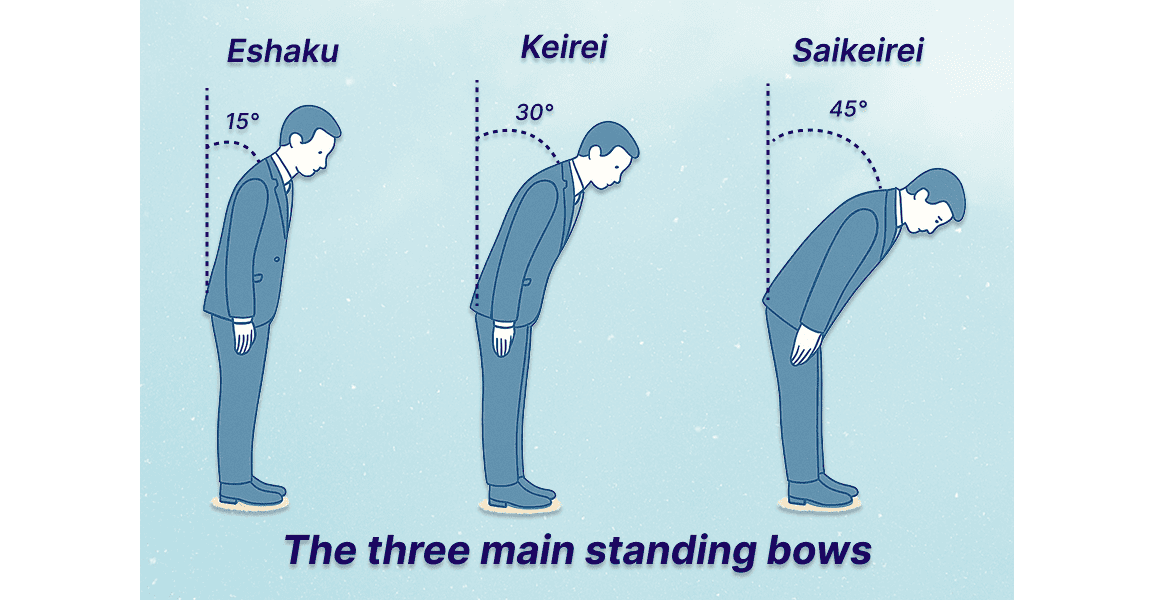
1. Eshaku (会釈) – The Casual Bow (~15°)
The eshaku is a light, casual bow performed with an inclination of about 15° from the waist.
It’s simple, friendly, and often done almost instinctively — a natural part of everyday life.
- When to use: Everyday greetings, brief encounters, or acknowledging someone in passing.
- Example: Greeting a colleague in the hallway, or thanking a shop clerk after a small purchase.
Think of it as a gentle nod with your whole body — quick, modest, and full of meaning.
Though small, this bow quietly conveys awareness and respect toward the other person.
2. Keirei (敬礼) – The Polite Bow (~30°)
The keirei is a polite bow performed at an angle of about 30° from the waist.
It is used in most formal or professional situations, striking a perfect balance between respect and approachability.
- When to use: When meeting someone for the first time, or expressing gratitude in business and public settings.
- Example: Hotel staff greeting guests, or employees welcoming clients to an office.
This is the “standard bow” most often seen in Japanese social and business interactions — sincere, respectful, yet natural in its flow.
3. Saikeirei (最敬礼) – The Deep Respect Bow (~45° or more)
The saikeirei is the deepest form of bowing, performed by bending the waist to about 45° or more and holding the position for several seconds.
It expresses the highest level of sincerity, humility, and respect toward the other person.
- When to use: When offering a heartfelt apology, showing deep gratitude, or honoring someone of high status.
- Example: A company representative bowing during a public apology, or expressing sincere appreciation to a mentor or respected leader.
The saikeirei is more than etiquette — it is a pure expression of emotion, a quiet act of reflection, gratitude, and sincerity that transcends words.
In this way, bowing holds as much meaning for the Japanese as spoken words themselves.
From a light greeting to a deep bow of apology or gratitude, each movement carries its own rhythm and emotion — allowing people to express their feelings with remarkable subtlety and sincerity.
Bowing in Everyday Life and Beyond
We’ve now seen the three main types of bows and how they are used in different situations.
But bowing in Japan goes far beyond these forms — it appears naturally in many other moments of daily life.
In this section, let’s take a closer look at how bowing is deeply woven into Japan’s traditions and cultural practices.
Religious Bows – Worship Etiquette
Bowing is also an important gesture in religious settings.
At Japan’s Shinto shrines and Buddhist temples, it carries a deeply spiritual meaning.
This type of bow is similar in form to the saikeirei, but it expresses reverence, not apology — a gesture of faith and humility rather than remorse.

- Shinto: Part of the traditional “two bows, two claps, one bow” (ni-rei, ni-hakushu, ichi-rei) ritual.
The final bow expresses reverence and gratitude to the kami (deities). - Buddhism: Often combined with gasshō (hands pressed together) to honor the Buddha, the teachings, and the temple.
- Purpose: Both in Shinto and Buddhism, bowing in sacred spaces represents deep respect, humility, and spiritual devotion.
In these settings, bowing becomes more than a gesture — it is a prayer in motion, quiet, heartfelt, and deeply personal.
Bowing in Modern Life – Choosing the Right Bow
Let’s take another look at how bowing appears in everyday life — this time, by situation.
Understanding when and how to use each type of bow makes it easier to see how deeply these gestures are connected to sincerity and respect in Japanese culture.
No matter the occasion, the purpose remains the same: to communicate honesty, gratitude, and respect toward others.
| Setting | Recommended Bow | Purpose / Situation |
|---|---|---|
| Everyday Encounters | Eshaku (~15°) | Used for casual greetings or brief interactions — such as in passing someone. |
| Business | Keirei (~30°) | Used for daily meetings and greetings. For important apologies or formal occasions, use Saikeirei. |
| Ceremonies (weddings, funerals) | Saikeirei (45°+) | To express deep respect toward families, elders, and honored guests. |
| Sports | Keirei (~30°) | Performed before and after matches to show mutual respect and goodwill. |
| Religious Sites | Saikeirei-style bow (45°+) | A spiritual bow performed with ritual elements to convey reverence. |
By understanding these subtle differences, you can appreciate how bowing in Japan goes beyond formality — becoming a quiet yet powerful language of gratitude, respect, and human connection that shapes everyday life.
The Etiquette – How to Bow Correctly
Bowing is one of Japan’s most important forms of etiquette.
At first glance, it may seem simple — just a polite gesture of lowering the head — but in truth, it follows clear and graceful rules of posture, movement, and timing.
So what makes a bow truly beautiful and elegant?
Let’s take a closer look at the steps and key points that define a proper bow, and discover how it reflects genuine respect in the Japanese way.
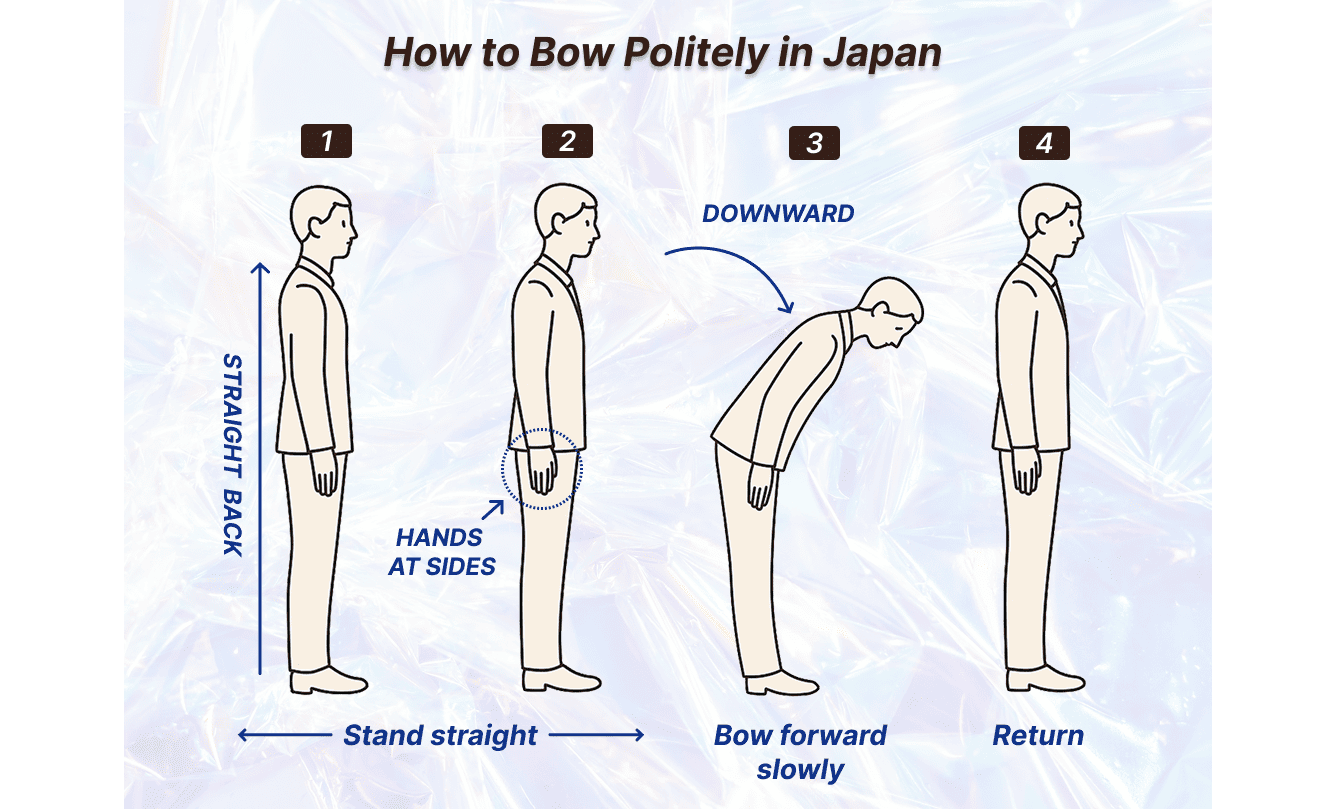
1. Keep Your Back Straight
Whether standing or sitting, keep your back straight, your shoulders relaxed, and your feet together.
Instead of bending from the neck, bow from the waist to create a clean and elegant posture.
This simple form expresses both self-control and sincerity.
2. Adjust Your Eyes and Neck
As you bow, your gaze will naturally lower, but be careful not to stare directly at the other person’s feet.
Keep your neck aligned with the line of your spine, and gently tuck in your chin without forcing it forward.
This creates a balanced and composed impression.
3. Place Your Hands Correctly
TIn modern Japan, the standard way to bow is to keep both hands naturally at your sides, regardless of gender.
This style is used in business, schools, and most public settings, as it shows equality and attentiveness.
In some traditional arts and ceremonies, however, women may still be taught to place one hand gently over the other in front of the body — a style that reflects classical elegance.
Either way, what matters most is a posture that feels balanced, respectful, and natural.
4. Coordinate Your Breathing
As you begin to bow, exhale slowly to help your body relax.
A calm, steady breath makes the motion feel natural and sincere.
In formal situations, you may pause briefly at the lowest point before returning upright — a small gesture that adds grace and composure.
5. Avoid Common Mistakes
It’s important to bow with sincerity and care, taking the time to express your feelings through the gesture.
Here are a few things to keep in mind:
- Talking while bowing: Speak before or after the bow, not during it, to show full attention and respect.
- Curved back: Keep your spine straight — a rounded back looks careless and weakens the impression of sincerity.
- Rushed movement: Move slowly and deliberately. A quick bow can seem impatient or insincere.
By following each step carefully, your bow will become both beautiful and graceful — a gesture that conveys not only proper form but also the sincerity of your heart.
A thoughtful, heartfelt bow expresses respect, gratitude, and honesty in any situation — whether you’re greeting someone, thanking a teacher, or taking part in a formal ceremony.
Hidden Meanings – The Spirit Behind the Bow
So far, we’ve explored the types of bows, their history, and the proper way to perform them.
Now, let’s take a step deeper and look beyond technique — to understand how bowing reflects the heart and spirit of the Japanese people.
The Inner Gesture – Lowering the Ego
As we’ve already seen, when Japanese people bow, it is not only a gesture of greeting or communication — it also carries the meaning of lowering one’s own position.
However, this act of placing oneself below another does not imply submission or self-deprecation.
Rather, it is a way of creating space for the other person to exist with dignity.
In Japanese culture, qualities such as enryo (restraint) and kenkyo (humility) are often seen as virtues — values that represent what is proper and even beautiful.
They remind people to show consideration and to approach others with respect and mindfulness.
Bowing gives form to these values through movement.
It transforms awareness, empathy, and modesty into visible action.
At its heart lies a timeless reminder: to always treat others kindly and with respect.
The Emotional Dialogue
Bowing is a quiet form of communication — a way to connect hearts without using words.
In a single gesture, a silent exchange takes place between two people, where feelings are shared not through speech, but through awareness and sincerity.

In Japanese culture, there is often an unspoken understanding — a sensitivity to sense what others feel or need without explicit words.
This ability to perceive and respond reflects a culture rich in empathy and emotional awareness.
Bowing, too, follows this same spirit.
Through one simple, graceful motion, far more is conveyed than words could ever express.
It becomes a dialogue of the soul, carried out in silence — a moment when understanding flows naturally from one heart to another.
Harmony and Awareness
Whether casual or formal, bowing plays a quiet yet powerful role in maintaining harmony between people.
Even when words are hard to find, a bow can open the door to understanding — a natural way to share emotion without speech.
A single bow can ease the tension of a first meeting, rebuild broken trust, or express respect that words alone cannot convey.
In every case, it fosters a shared awareness between people — a moment of mutual recognition and empathy.
In this sense, bowing is more than etiquette.
It is an art of human connection, born from the Japanese sensitivity to time, space, and the presence of others.
To bow, then, is to pause — a moment to return to humility.
It reflects not only personal manners, but also the spirit of an entire culture.
Within a single bow lives the essence of Japanese character: humility, sensitivity, and harmony.
It embodies the kindness to care for others, the grace to listen before speaking, and the quiet strength to honor every encounter.
Bowing is, in many ways, a gentle art — a living expression of respect, empathy, and connection that continues to define Japan today.
Modern Adaptations – From Airports to Anime
While bowing is deeply rooted in Japanese tradition, it remains a natural part of modern Japanese life.
In this section, let’s take a closer look at how ojigi continues to appear in everyday moments — how it has evolved, and in what situations it still conveys respect and connection today.
Professional Hospitality
In places like airports, hotels, and department stores, bowing has become an essential part of professional service.
Employees perform precisely timed, standardized bows, usually keirei (around 30°) or saikeirei (around 45°), often paired with greetings such as irasshaimase (“welcome”) or arigatō gozaimasu (“thank you”).
These gestures project warmth, attentiveness, and professionalism — qualities at the heart of Japan’s world-renowned hospitality.
Bowing is not only taught from childhood but also refined through formal business and service training in adulthood.
For many professionals, mastering the bow is a lifelong practice — a visible expression of respect that transforms etiquette into art.
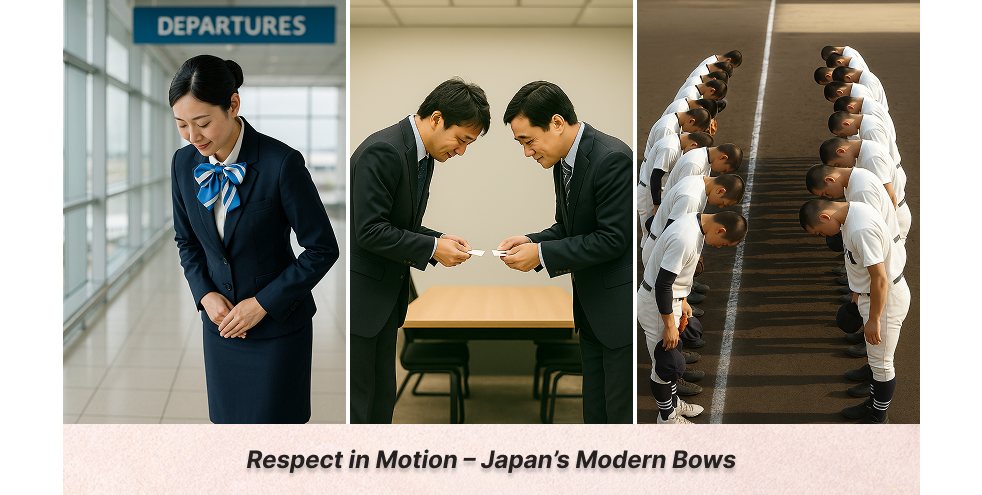
Sports and Public Ceremonies
Bowing is also a familiar sight in Japan’s sports culture.
Before and after matches in judo, kendo, baseball, or soccer, athletes bow to their opponents, referees, and spectators.
This simple gesture reflects mutual respect, gratitude, and sportsmanship, reminding both players and audiences that competition begins and ends with courtesy.
In award ceremonies, athletes and public figures often combine a bow with the act of receiving a medal or trophy — blending traditional decorum with modern celebration.
Even in moments of victory, humility remains at the heart of Japanese expression.
Pop Culture and Media
In Japanese anime, films, and television dramas, bowing appears in countless everyday moments.
From classroom greetings and press conferences to shrine visits and emotional farewells, these scenes reflect Japan’s deep sense of courtesy and respect.
What you see in these stories is not just a performance — it mirrors real life.
The gestures and manners portrayed in Japanese media often come directly from daily customs.
So when a character bows in an anime or film, it represents how real people in Japan bow in similar situations today.
These depictions capture how naturally bowing is woven into Japanese life.
Even in the smallest interactions, a quiet sense of respect can be felt.
Through stories and imagery, Japanese works continue to share the beauty of ojigi culture with audiences around the world.
In this way, bowing remains an essential part of life in Japan, even in the modern age.
This timeless tradition continues to be passed down — connecting generations, and carrying its quiet spirit of respect and harmony into the future.
Conclusion – A Gesture That Speaks Without Words
Bowing in Japan is more than a polite formality — it is a living expression of respect and harmony that has quietly evolved through the centuries.
From its beginnings in the ancient imperial court to the refined bows of the samurai, the grace of the tea ceremony, and the professionalism of modern hospitality — ojigi continues to bridge tradition and the present with elegance and sincerity.

For the Japanese, every bow carries meaning.
The depth reveals the degree of respect, the duration reflects sincerity, and the posture expresses awareness of others.
For visitors, learning to bow is not merely about imitation — it is about embracing a mindset that values harmony, empathy, and mutual regard.
Whether in a bustling airport or a quiet shrine, a bow can still convey more than words ever could.
And in that brief, silent moment, you may find yourself not just witnessing Japanese culture — but quietly becoming a part of it.